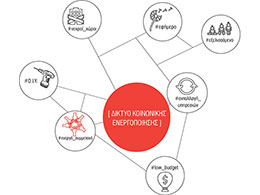STUDENTS PROJECTS
PROJECTS2013
Students : Lasithiotaki Melina, Botsi Tina, Christopoulou Hara
Supervisor professor: Konstantinos Oungrinis
Architectural Engineering School of Technical University of Crete
Presentation date : 2014/10/10
The motivation for this project stemmed from the concern over to what extent the urban residents of Chania could perform their activities and relate to their environment.
In contemporary social settings, particularly in times of recession, people tend to enter a state of inertia. As a result they appear incapable of promoting relations or even maintaining existing ones.
Shops and businesses are abandoned in the city centre. Public amenities and facilities fall into disrepair. Subsequently the town' s image is altered and with every aspect of life in decline there is a sense of discontinuity in the fabric of urban society. Under these circumstances social renewal cannot occur unless the members of the community develop relations based on trust while sharing a collective spirit in their everyday life.
The aim of this project therefore is to set in motion existing social and community networks as well as create new ones.
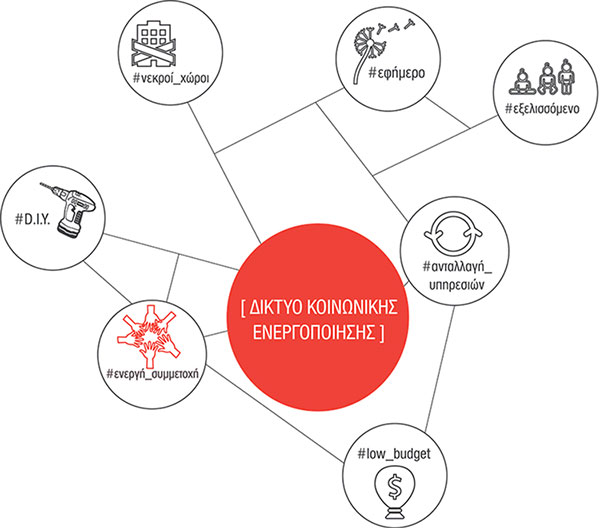
Mind-map
More analytically we initially compiled a list of the town's utilities and urban amenities such as card phones, recycling bins, location maps, bicycle stands and information kiosks. At the same time we listed each of the abandoned locations in the centre of Chania.
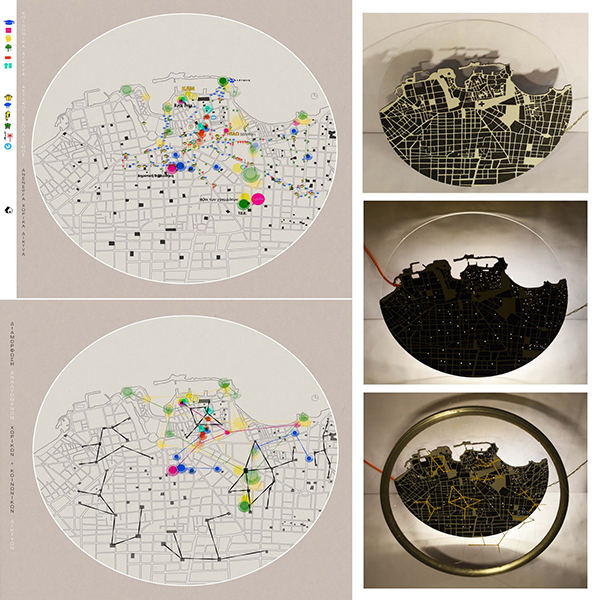
- Diagram of the recorded network of Chania / community network, urban amenities, abandoned locations.|
- Diagram of the transformation of potential community and social networks in Chania
- Template illustrating abandoned locations - revived hubs of activity.
We subsequently composed a questionnaire in order to pinpoint the current needs of the town citizens and what was lacking. One key question was their willingness to volunteer their skills and services and become actively involved in the program
Would it be better to form a team to take the initiative or set up a network of activities?
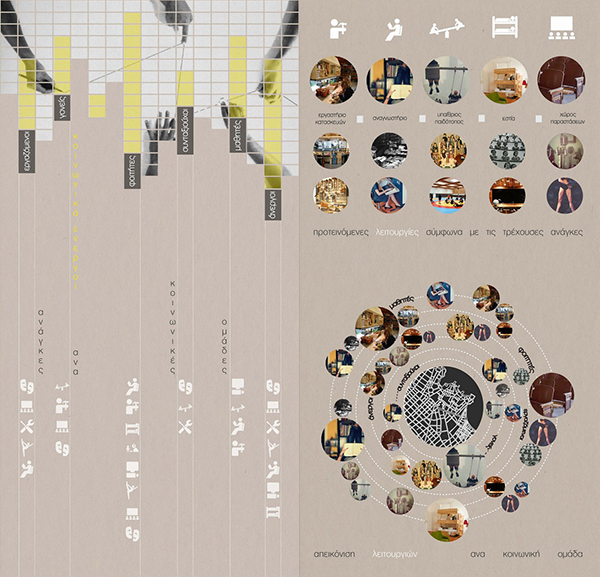
- Diagram of the number of participating citizens in proportion to those questioned
- Diagram illustrating proposed operations for each social group.
The young graduates of Chania were considered the most suitable subjects for this operation as they are at transitional stage and in the process of resetting their goals.
Through a series of interviews we investigated their viewpoints and ideas regarding our main query:
How this network would be structured, what functions it could serve, where it would be accommodated, how it could be developed.
We created a scenario of community participation to utilize some of the abandoned properties. The procedure was initially confined to five of these locations which are already in operation.
The sign plan for these properties involved the use of structures made out of everyday, low-cost, recyclable materials such as wooden crates and scaffolds, which were innovatively assembled to create aesthetic appeal. No major structural work was done to the existing building, but subtle changes to the facades and transformation of the interior layout and design turned them into community activity centers that serve a designated function.
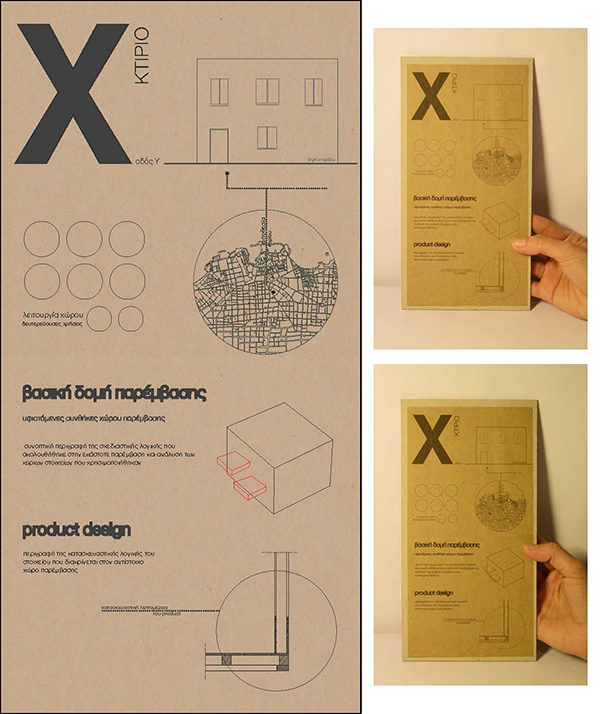
Summary of design strategies that where applied in different levels of the interventions in each space.
Annotation of the reasoning behind the sign and plan of action for each renovated property on tree scales.
The larger scale shows the locations of the five renovated properties on the town map of Chania as well as the functions they serve in relation to the prerequisites of each area.
The smaller scale illustrates the fundamental structural intervention of each property according to its function and how it serves the user's needs.
The final process scale represents the structural details of each product that was created in the location and how it fits in with the overall intervention.
These processing scales helped us to design perceptible quality spaces by examining an extensive range of processes to utilize and transform the available materials in order to create an inviting , aesthetically- pleasing environment.
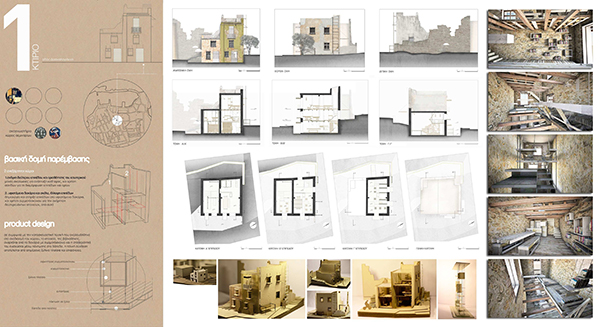
Building 1 - Daskalogianni Street
The specific building is located in the centre of the old town of Chania; a busy area frequented by young people throughout the day. In view of this it was chosen to operate as a place to read, hold seminars and give presentations.
The building consisted of two separate spaces. In the smaller of the two it was necessary to create a floor and compartmentalize the interior without the aid of any existing structures. To achieve this a single scaffold was used to create a raised level , a combination of planks were placed on top for flooring and panel screens divided up the space. In the larger area new levels were supported by existing beams and smaller features were suspended with wire.
In accordance with the design plan the facility created was a library which is suspended from the beams with wired and supported with wooden crates on the floor. The final structure consists of allocated wooden frames and surfaces.
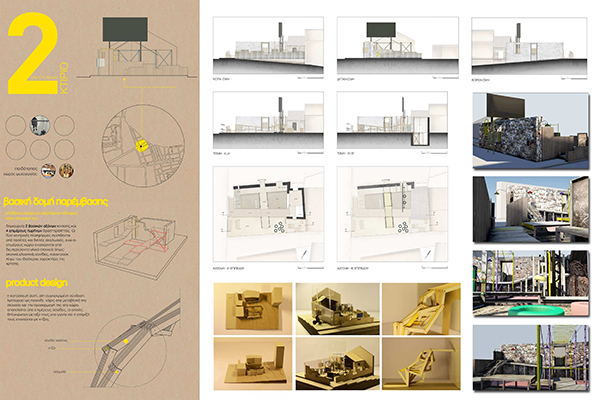
Building 2 - Nik. Foka Street
Located in the Kum Kapi area this property includes an adjoining open- air area which is walled off from the side road. In view of this it was deemed safe for children and in accordance with the neighbored needs this property was transformed into a playground and children's recreation facility.
The open area was converted into two principle axles for play and four allocated activity zones. The central play area is accessed from the main entrance and leads to the existing building. The two central platforms are composed of crates and double scaffolds creating an elevated "runway". The allocated areas are equipped with other materials such as ropes, tires, planks and rubber in relation to its specific utility.
The facility created in this location is a play area on two levels. Its comprises allocated boards, interconnected at the corners and sides and supported by wire cables.
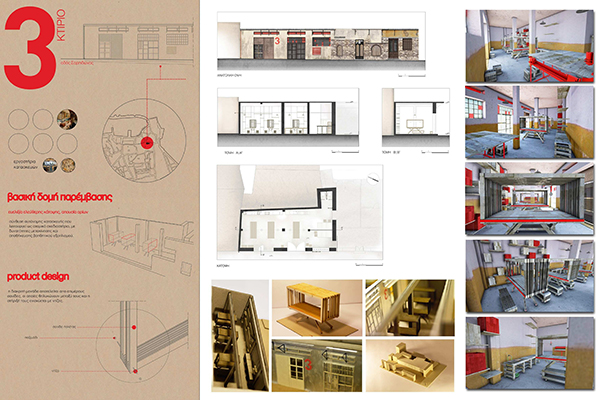
Building 3 - Sarpidones Street
Located in the "Old Town" area this property has direct access to the road and an extended open plan layout as it was formally a car- repair shop. In accordance with the area's needs it was designated to operate as a workshop.
Due to the flexibility of the layout and its lack of confines it was feasible to create an autonomous structure which functions as an independent design workshop that allows equipment to be store and maneuvered. The completed unit was composed of allocated, interconnected boards reinforced with wire cables. Small trolley weels were added to the base of the unit to facilitate movement.
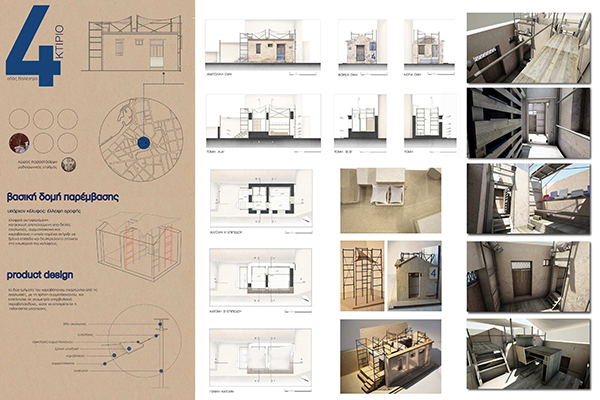
Building 4 - Valestra Street
This building is situated in the Nea Chora area. Our initial research pointed out the need for a facility to stage performances and house a mode of creative expression. On the basis of this it was decided to transform this property into a small radio station and open- air theatre.
The basic structural element of the building was the absence of a roof which required the design and completion of a lightweight self- supporting structure composed of double scaffolds , wire and canvas to serve as a canopy. In conjunction the construction includes reinforcement of the levels and secondary features on the interior.
The final product is the specific structure in which the two sections of canvas are suspended from the scaffolds using wires and are extended in an exaggerated geometric parabola (curveball projectile) to prevent concavity.
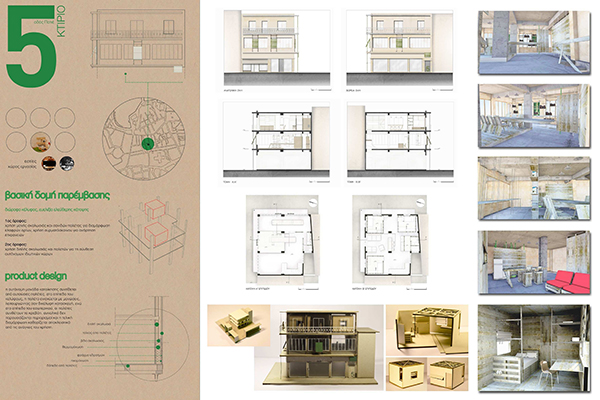
Building 5 - Potie street
This building is centrally located in the Old Town of Chania and modifications were made to the two floors which had previously been used as storerooms for the groundfloor shop. This building was designated as a workplace and living quarters for the young community service team of engineers.
The original structure comprised a flexible, unrestricted layout. On the first floor strong vertical boundaries were formed using a single scaffold and boards and light horizontal surfaces were formed with boards and wire.
On the second floor individual living units were created composed of double scaffolds and single wooden crates.
The exterior of the crate was reinforced with insulating materials creating a double -layered structure while on the interior a bed was formed out of crates.
Overall there are no restrictions and the final design/ arrangement can be entirely determined by the occupant's requirements.
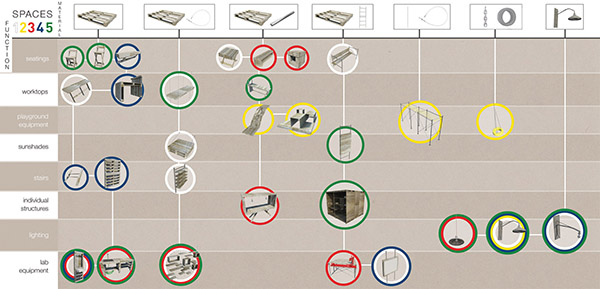
Composite table of facilities together with the basic materials used, their application and the property in which they are housed.
